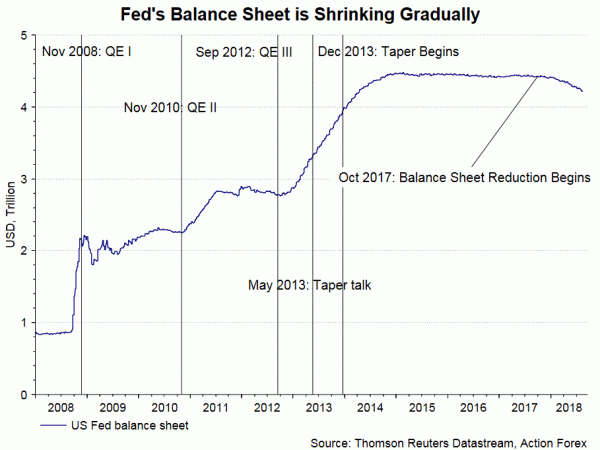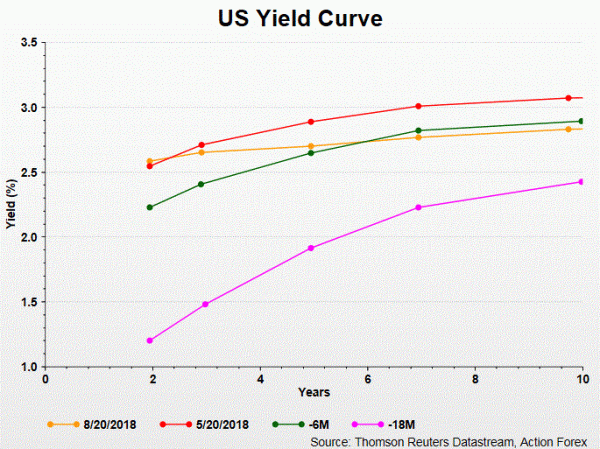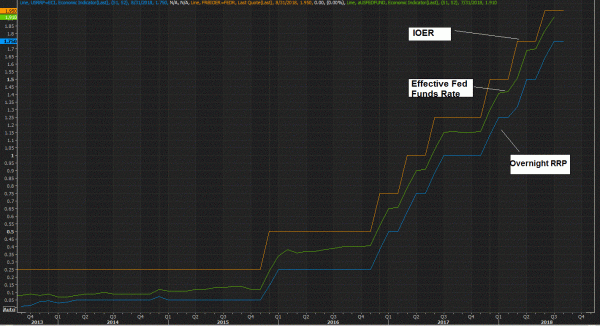While it is not a practice for Fed chairs to offer hints on the monetary policy outlook at the annual Jackson Hole symposium, their speeches at the event have always caught market attentions and sometimes move the market. At the upcoming meeting on August 23-28, Fed Chair Jerome Powell would be speaking on the topic “Changing Market Structure and Implications for Monetary Policy”. We expect his speech would focus on the more technical mechanism of the monetary policy implementation. Yet, we find two areas that might still trigger market volatility.
- Early End of Balance Sheet Reduction?
The Fed, as it announced the plan to trim its US$ 4.5 trillion-worth balance sheet in October 2017, did not indicate the targeted final size of the balance sheet. However, as some members signaled at that time, the preferred size would be about US$ 2.5-3 trillion. Powell, as he testified before the Committee on Banking, Housing, and Urban Affairs for his nomination back in November, also suggested a similar amount. The process should take 3-4 years to complete.
Speculations that the reduction could end in as soon as next year heightened as Powell noted at the semi-annual testimony to Congress last month that the Fed would take up the question about the size of its balance sheet “fairly soon”. While higher effective Fed funds rate resulting from balance sheet reduction (lower Fed reserve) is anticipated, any hint of early completion of balance sheet reduction would be very dovish and should cause US dollar to fall. Also, larger System Open Market Account (SOMA) Treasury holding by the Fed means less T-bill issuance in the future. This could result in the decline in short-term yields, giving a relief to the flattening of yield curve.

2. Return to Pre-Crisis Channel System Monetary Policy?
Prior to the 2007-08 global financial crisis prior, the Fed conducted monetary policy using a so-call a channel system. While the discount rate and the interest rate on excess reserve (IOER) as the upper and lower limits, respectively, the Fed funds rate was targeted in between.
Such mechanism has been changed since October 2008, as the Fed began paying interest on excess reserve. The move was adopted to accommodate the abundant reserve. Meanwhile, the Fed introduced the overnight reverse report rate (ON RRP), which is lower than IOER. Indeed, both IOER and ON RRP are rates at which financial institutions lend to the Fed. The difference is that the Fed puts up securities as collateral for the latter. For the10 years since then, the Fed’s policy rate – the Fed funds rate is announced as a target range, with upper and lower bounds given by the IOER and the ON-RRP rate, respectively.
As New York Fed President William Dudley suggested, the major difference between the corridor and the floor system is as follows: “In a corridor system, reserves in the banking system are scarce, and the Fed funds rate is set by adjusting the supply of reserves through open market operations to balance demand and supply at the FOMC’s target range. In contrast, in a floor system, reserves are abundant, so that the interest rate the Fed pays on excess reserves, or IOER, is the primary tool used to control the federal funds rate. As Fed is trimming its balance sheet, the reserve is prone to be significantly lower than the level years ago. Some have raised that a return to channel system might be considered. Powell might comment on this area but we expect the Fed should maintain the current system for some time. Currently, how much the Fed would reduce its balance sheet (point 1) would also affect whether and when to adjust the system.
Powell is unlikely offer more indications on the future rate hike path than what had been discussed in the June and August meetings. The Fed is set to raise the policy rate by +25 bps in September, followed by another in December. There would likely be another 4 hikes in 2019.














